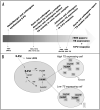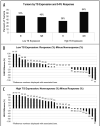Evaluating the drug-target relationship between thymidylate synthase expression and tumor response to 5-fluorouracil. Is it time to move forward?
- PMID: 18443433
- PMCID: PMC3081718
- DOI: 10.4161/cbt.7.7.6181
Evaluating the drug-target relationship between thymidylate synthase expression and tumor response to 5-fluorouracil. Is it time to move forward?
Abstract
Thymidylate synthase is a target of 5-fluoruracil, a pyrimidine analog used to treat gastrointestinal and other cancers. The 5-fluorouracil metabolite, fluoro-deoxyuridine monophosphate, forms a ternary complex with thymidylate synthase and 5,10-methylene tetrahydrofolate. The purpose of this study was to evaluate the time-honored connection between thymidylate synthase and 5-fluorouracil. From our literature search spanning reports from 1995 to 2007 published in journals having an impact factor greater than 2, we stratified the tumors within each article, according to low versus high thymidylate synthase expression. These groups were subdivided into responders, stable disease or disease progression. The relationship between thymidylate synthase expression and 5-fluorouracil response was analyzed for the overall group, as well as for subsets. Overall, the literature supported an approximately 2-fold inverse relationship between thymidylate synthase expression and response to 5-fluoruracil. We found no change in the trend for a relationship between thymidylate synthase and 5-fluorouracil when the literature was stratified by date of publication, impact factor of the journal in which the report was published, or substrate (mRNA versus protein) for measuring thymidylate synthase expression. Of note, there is no significant change in the trend when comparing 5-fluorouracil treatment alone or in combination with leucovorin. We found a decline of this trend when certain chemotherapeutics were used in combination with 5-fluorouracil. In sum, the connection between thymidylate synthase expression and patient response to 5-fluorouracil does not satisfy expectations for an effective drug-target relationship; and thus, studies of the thymidylate synthase tandem repeat status might only be clinically valuable in regards to patient toxicity. Thus, we question the reliability of thymidylate synthase expression as a clinical predictor of 5-fluorouracil response. Future research could perhaps be directed towards alternate targets and metabolites of 5-fluorouracil, in an effort to find a clinically relevant biomarker panel for response and to optimize fluoropyrimidine-based therapy.
Figures



Comment in
-
Thymidylate synthase and 5-fluorouracil: a cautionary tale.Cancer Biol Ther. 2008 Jul;7(7):995-6. doi: 10.4161/cbt.7.7.6414. Epub 2008 Jun 4. Cancer Biol Ther. 2008. PMID: 18698159 No abstract available.
References
-
- Lokich J. Infusional 5-FU: Historical evolution, rationale and clinical experience. Oncology (Williston Park) 1998;12:19–22. - PubMed
-
- Longley DB, Harkin DP, Johnston PG. 5-Flurouracil: Mechanisms of action and clinical strategies. Nature Rev Cancer. 2003;3:330–8. - PubMed
-
- Rutman RJ, Cantarow A, Paschkis KE. Studies on 2-acetylaminofluorene carcinogenesis: III. The utilization of uracil-2-C 14 by pre-neoplastic rat liver. Cancer Res. 1954;14:119–26. - PubMed
-
- Grem JL. 5-fluorouracil: Forty-plus and still ticking. A review of its preclinical and clinical development. Invest New Drugs. 2000;18:299–313. - PubMed
-
- Heidelberger C, Chaudhuri NK, Dannenberg P, Mooren D, Griesbach L, Duschinsky R, Schnitzer RJ, Pleven E, Scheiner J. Fluorinated pyrimidines: A new class of tumour inhibitory compounds. Nature. 1957;179:663–6. - PubMed
Publication types
MeSH terms
Substances
Grants and funding
LinkOut - more resources
Full Text Sources
